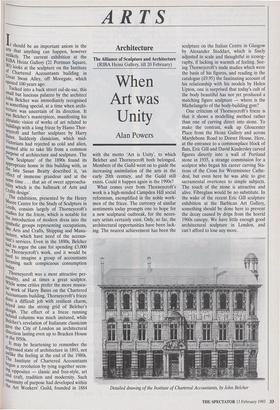ARTS
Architecture
The Alliance of Sculpture and Architecture (RIBA Heinz Gallery, till 20 February)
When Art was Unity
Alan Powers
&t should be an important axiom in the ans that anything can happen, however h,11111IkelY. The current exhibition at the '‘IBA Heinz Gallery (21 Portman Square, WI) looks at the sculpture on the Institute of Chartered Accountants building in Great Swan Alley, off Moorgate, which opened 100 years ago. Tucked into a back street cul-de-sac, this small but luscious palazzo by the architect John Belcher was immediately recognised as something special, at a time when archi- tecture was uncertain of its direction. It was Belcher's masterpiece, manifesting his Puddings vision of works of art related to Puddings with a long frieze by Hamo Thor- aheYcroft and further sculpture by Harry Sates. Suddenly classicism, which mid- Victorians had rejected as cold and alien, seemed able to take life from a common LutPose of architecture and sculpture. The New Sculpture' of the 1890s found its appropriate home in this building with, as the late Susan Beatty described it, 'an effect of immense grandeur and at the talUe time . . . that air of sweet approacha- tY is the hallmark of Arts and `rafts design'. "The exhibition, presented by the Henry Moore Centre for the Study of Sculpture in weds, consists largely of Thorneycroft's studies for the frieze, which is notable for the introduction of modern dress into the sLitthnlic groups representing occupations, Like Arts and Crafts, Shipping and Manu- facture, which have need of the accoun- tant's services. Even in the 1890s, Belcher 'ad to argue the case for spending £3,000 Thorneycroft's work, and it would be hard to imagine a group of accountants Licensing such conspicuous consumption today. Thorneycroft was a most attractive per- sonality, and at times a great sculptor. bile some critics prefer the more muscu- lar work of Harry Bates on the Chartered Accountants building, Thorneycroft's frieze keyed a difficult job with resilient charm, ..ln. eYed into the strong grid of Belcher's ruei. 5 The effect of a frieze running ?„ehind columns was much imitated, while behind revelation of Italianate classicism ,8 the City of London an architectural t'rection lasting even up to Bracken House In the 1950s. It may be heartening to remember the "ePressed state of architecture in 1893, not 1,41111ke the feeling at the end of the 1980s. began Institute of Chartered Accountants a revolution by tying together seem- opposites — classic and free-style, art 'Id craft, tradition and modernity. Such ,ItilanImity of purpose had developed within Lue Art Workers' Guild, founded in 1884 with the motto 'Art is Unity', to which Belcher and Thorneycroft both belonged. Members of the Guild went on to guide the increasing assimilation of the arts in the early 20th century, and the Guild still exists. Could it happen again in the 1990s?
What comes over from Thorneycroft's work is a high-minded Campden Hill social reformism, exemplified in the noble work- men of the frieze. The currency of similar sentiments today prompts one to hope for a new sculptural outbreak, for the neces- sary artists certainly exist. Only, so far, the architectural opportunities have been lack- ing. The nearest achievement has been the sculpture on the Italian Centre in Glasgow by Alexander Stoddart, which is finely adjusted in scale and thoughtful in iconog- raphy, if lacking in warmth of feeling. See- ing Thorneycroft's nude studies which were the basis of his figures, and reading in the catalogue (£9.95) the fascinating account of his relationship with his models by Helen Upton, one is surprised that today's cult of the body beautiful has not yet produced a matching figure sculpture — where is the Michelangelo of the body-building gym?
One criticism of Thorneycroft's frieze is that it shows a modelling method rather than one of carving direct into stone. To make the contrast, walk up Gloucester Place from the Heinz Gallery and across Marylebone Road to Dorset House. Here, at the entrance to a commonplace block of flats, Eric Gill and David Kindersley carved figures directly into a wall of Portland stone in 1935, a strange commission for a sculptor who began his career carving Sta- tions of the Cross for Westminster Cathe- dral, but even here he was able to give sacramental overtones to simple subjects. The touch of the stone is attractive and alive. Fibreglass would be no substitute. In the wake of the recent Eric Gill sculpture exhibition at the Barbican Art Gallery, something should be done here to prevent the decay caused by drips from the horrid 1960s canopy. We have little enough good architectural sculpture in London, and can't afford to lose any more.
Detailed drawing of the Institute of Chartered Accountants, by John Belcher


















































 Previous page
Previous page